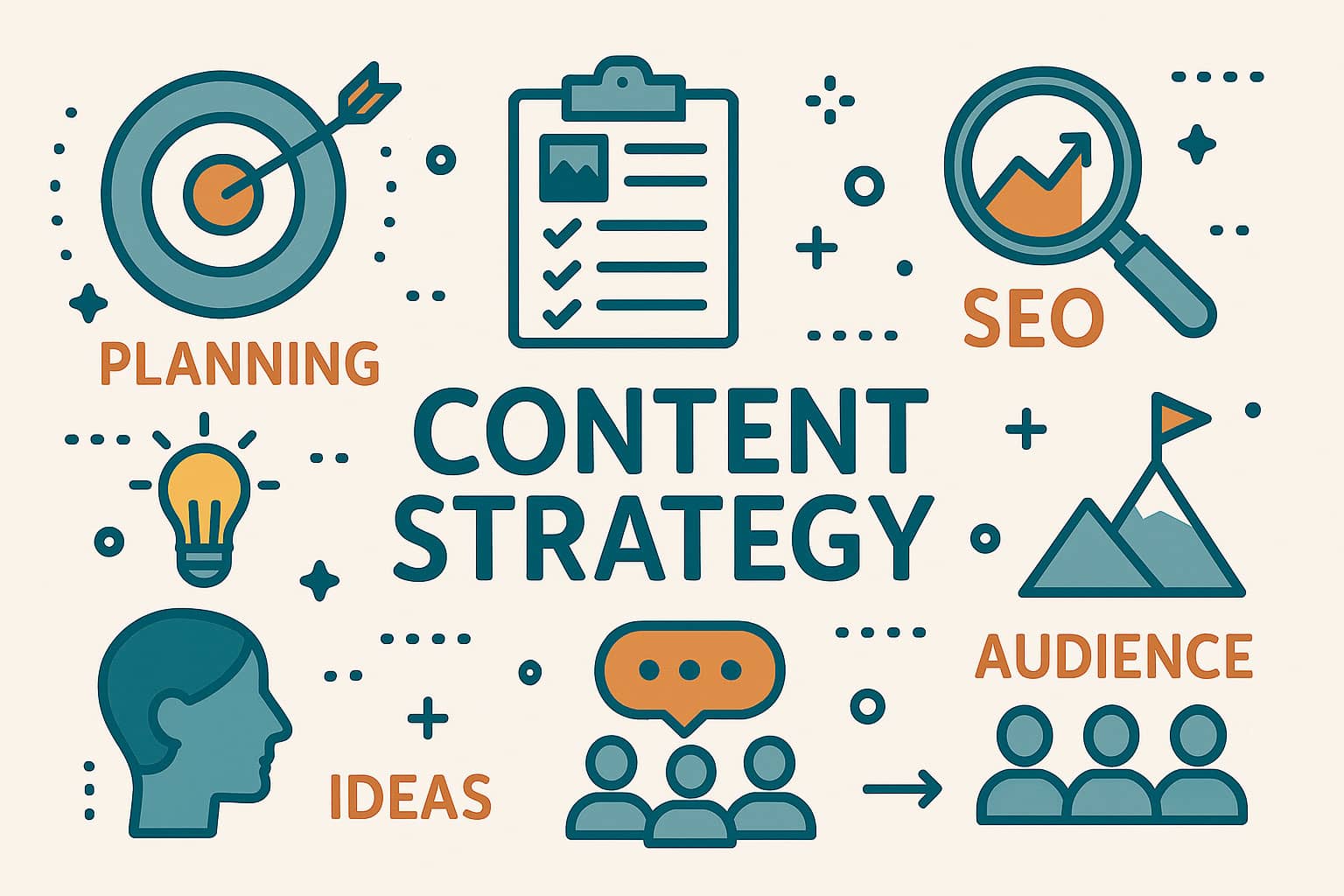Content Strategy for SEO: Why It Is the Backbone of Success
A content strategy transforms your digital environment from random wandering to purposeful navigation. Developing a winning SEO content strategy is critical for achieving SEO success, as it provides a clear roadmap for creating content that drives results. You’ll convert scattered assets into a targeted ecosystem that aligns with search algorithms and user intent. An effective SEO content strategy involves strategic keyword placement, interconnected and internally linked content, and precise audience targeting to maximize organic visibility and site authority. By optimizing each content piece, you’ll gain higher search rankings with more meaningful engagement. This stage of planning is crucial for establishing a solid foundation for SEO success. Want to supercharge your SEO performance? The blueprint awaits.
Key Takeaways
- A content strategy precisely aligns digital assets with user search behaviors, transforming random content into targeted, purposeful navigation for search engines.
- Strategic keyword research and implementation create interconnected content ecosystems that enhance site authority and improve organic search rankings.
- Optimized content bridges the gap between brand messaging and audience queries, generating valuable resources that boost search visibility and engagement.
- A comprehensive content strategy converts static web pages into dynamic conversion pathways, reducing bounce rates and increasing meaningful user interactions.
- Continuous tracking and refinement of content approach ensures technical precision and adaptability to evolving search algorithm requirements and user intents by monitoring key performance indicators such as traffic, keyword rankings, and conversions.

SEO content strategy works a lot like navigating a ski resort. Your distribution channels—like email, social media, and search—act as the lifts, moving users seamlessly across your content terrain. Internal linking is your gondola system, ensuring smooth transitions and elevated visibility. UX elements such as CTAs, breadcrumbs, and related links function like trail signs, guiding users so they don’t get lost mid-journey. And just like snow conditions affect the slopes, Google’s ever-changing algorithms impact your rankings, making regular audits and content refreshes essential to stay in top shape.
Why Content Strategy Is the Backbone of SEO Success
In the ever-evolving terrain of search engines, a strong SEO content strategy acts like your trailmap—guiding every step with purpose. It connects your brand with real user intent, transforms keywords into meaningful assets, and ensures your visibility is both strategic and sustainable. Without it, you’re just wandering the mountain.
1. Introduction
Navigating the digital landscape without a plan is like heading into Colorado’s backcountry without a trailmap—possible, but risky and inefficient. A well-defined SEO content strategy brings structure to the journey, turning random online wandering into focused, intentional exploration. It directs organic traffic through paths that are thoughtfully designed around how real people search and how algorithms evaluate.
Creating content isn’t enough. You need assets that connect your brand’s message with what your audience is actually looking for. That starts with identifying high-impact keywords and building content that responds to genuine intent. When done right, your site becomes more than searchable—it becomes discoverable, relevant, and trusted.
Just like respecting the terrain ensures a smoother climb, aligning your content strategy with your business goals and audience needs positions your brand for sustained growth and visibility. In Colorado terms? You’re not just making tracks—you’re carving out your competitive edge.
2. What Is a Content Strategy?
A content strategy serves as your systematic blueprint for creating, distributing, and managing digital content that strategically aligns with business objectives and audience search behaviors. This technical approach leverages keyword research for content to map precise user needs with targeted digital assets.
| Strategy Component | Purpose |
|---|---|
| Audience Targeting | Identify specific user search intents |
| Keyword Research | Research keywords to uncover high-value search queries |
| Content Planning | Develop relevant, optimized content assets |
Creating relevant content is essential for engaging your audience and improving SEO outcomes.
Your content strategy converts raw data into actionable insights, enabling you to craft digital experiences that resonate with search algorithms and human audiences. By systematically analyzing search patterns, understanding user intent, and developing strategically optimized content, you’ll create a powerful SEO framework that drives organic engagement and supports thorough digital marketing objectives. Use keyword research to create relevant content that addresses user needs and stands out in search results.
3. How Content Strategy Powers SEO for Search Engines
A well-executed content strategy is crucial to transforming SEO potential into tangible, measurable results. It brings structure to your website by aligning your messaging with what search engines and your audience are actually looking for. Your content marketing efforts become a true SEO driver when you:
- Make sure your content meets both user search intent and audience needs
- Place keywords strategically across your pages
- Build interconnected, high-value content that supports broader business goals
Crafting a content strategy for SEO takes thoughtful planning. Mapping keywords to distinct stages of the user journey helps turn passive pages into active conversion points. When your content is tied to targeted landing pages, it boosts visibility in search results and strengthens your marketing performance. Each article or page serves as a guidepost, helping both users and algorithms navigate a clear, well-structured digital landscape. The payoff? Better rankings, higher engagement, and a smoother experience across the board.
4. The SEO and Organic Traffic Benefits of a Strong Content Strategy
Navigating SEO without a content strategy is like paddling blind through Class IV rapids—chaotic, unpredictable, and rarely successful. A solid content strategy helps you read the river, steering your site’s narrative toward high-impact search visibility and audience connection. For small businesses, that means:
- Aligning content with real user search intent and audience needs
- Placing keywords strategically across key landing pages
- Building interconnected content that flows naturally and adds value
Mapping keywords to user journeys transforms static pages into conversion channels, letting your content ride the current instead of fight it. Each post becomes a guidepost, pulling qualified traffic downstream while signaling relevance to search engines. With consistent tracking and optimization, your site’s authority builds, creating smoother engagement, stronger visibility, and a digital presence that stays upright, no matter the conditions.
5. Common Mistakes When SEO Lacks Content Strategy
Steering SEO without a solid content strategy can derail your digital marketing efforts, leading to critical missteps that undermine search performance.
- Keyword Stuffing: Cramming keywords without context destroys readability and triggers search engine penalties.
- Thin Content: Publishing shallow, non-substantive pages that lack meaningful information reduces site authority.
- Missed Keyword Opportunities: Neglecting long-tail and local SEO keywords limits potential organic traffic.
- Ignoring Audience Pain Points: Failing to address your audience’s pain points results in content that doesn’t resonate or solve real problems, making it less effective at attracting and converting visitors.
Differentiating your content from other sites by providing original, high-quality information and demonstrating authority is essential for standing out in search results.
Effective SEO content planning demands strategic alignment between user intent and content creation. Content strategy examples for SEO websites demonstrate how targeted, purposeful content drives search rankings. Without a thorough approach, you’ll generate disconnected pages that fail to guide users through a coherent digital journey, ultimately diminishing your website’s search visibility and engagement potential.
Regularly checking for and fixing broken links is also crucial for maintaining accurate information and supporting ongoing SEO performance.
6. How to Build an SEO-Focused Content Strategy with Keyword Research
It starts with understanding your audience—defining detailed personas and their search intent—then identifying high-value keywords that match both their queries and your unique strengths. From there, organize content across the buyer journey using a strategic editorial calendar, focusing on topics with strong organic potential and crafting authoritative content that answers specific questions.
Each page should be optimized with clean titles, clear headers, and natural keyword placement, while metadata, URL structures, and internal linking work behind the scenes to support visibility and site structure. The process doesn’t stop at publishing—ongoing refinement through analytics, performance tracking, and mobile optimization keeps your content fresh and relevant. Sharing visually engaging assets across social media extends reach and boosts engagement.
Off-page, a thoughtful link-building strategy using organic outreach, content partnerships, and digital PR strengthens domain authority. All this ties back to demonstrating Google’s E-E-A-T principles—Experience, Expertise, Authoritativeness, and Trustworthiness—which contribute to better rankings and increased traffic. In short, an SEO-driven content strategy isn’t just tactical—it’s the engine for sustainable digital growth.
8. Conclusion
A strong content strategy is the backbone of search engine optimization success, ensuring your efforts improve content visibility and online reach. While SEO content strategies might seem complex, they’re fundamentally about connecting user needs with strategic digital solutions. By leveraging seo writing tips and best tools for seo content planning, you’ll elevate your digital presence from scattered content to a targeted, performance-driven ecosystem.
Your strategy isn’t just about ranking—it’s about delivering precise, valuable information that meets searcher intent. Effective content planning means understanding keyword nuances, crafting compelling narratives, and systematically optimizing each piece of content.
Track your performance meticulously. Use analytics to refine your approach, identify content gaps, and continuously improve your search visibility. Remember, successful SEO isn’t a one-time effort but an ongoing, data-driven process of strategic adaptation and refinement.
Content Strategy Definitions – Important Terms to Know
Content Strategy
A structured plan for creating and managing content that supports your business goals, connects with your audience, and delivers long-term value.
Audience Persona
A detailed profile of your ideal customer, based on real data and behavior. It helps shape content that speaks directly to their needs, interests, and challenges.
Content Calendar
A planning tool that outlines what content will be published, when, and where. It keeps your messaging consistent and aligned with business priorities.
Call to Action (CTA)
A prompt that encourages users to take a specific action—like “Schedule a Consultation” or “Download the Guide.” Every piece of content should include a clear CTA to guide engagement.




